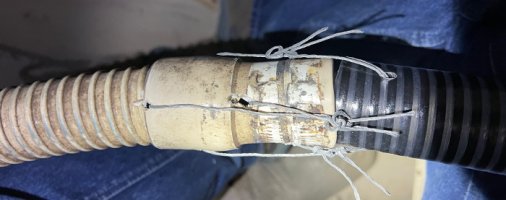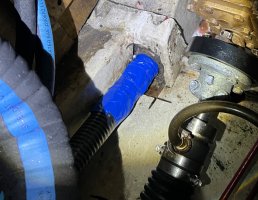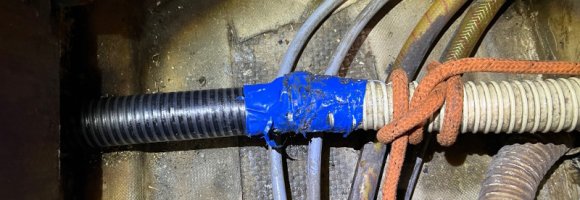The diaphragm's on my Jabsco bilge pumps seem to last 20 years or more. What is the life expectancy for the vanes in your model? I change out the impeller in the raw water pump on our engine at least every other year, but I do not know how long it might last if ignored...We installed the two vane pumps yesterday.
-

Untitled Document The 2024-2025 Fund Raising Season has Opened!
EricsonYachts.org has opened the season for raising funds to support the expenses of the site. If you would like to participate, please see the link below for additional information.
Thanks so much for your continued support of EricsonYachts.org!
You are using an out of date browser. It may not display this or other websites correctly.
You should upgrade or use an alternative browser.
You should upgrade or use an alternative browser.
Bilge Hose Replacement Battle
- Thread starter Nick J
- Start date
Frank Langer
1984 Ericson 30+, Nanaimo, BC
One should not ignore a pump with an impeller. A few years ago I spoke with a Jabsco Rep who advised the following: 1) apply grease that doesn't degrade rubber when installing the impeller, 2) run the pump for a few seconds several times per month to avoid the impeller developing a set, 3) ensure the wires are the correct size to minimize voltage drop and are corrosion free.The diaphragm's on my Jabsco bilge pumps seem to last 20 years or more. What is the life expectancy for the vanes in your model? I change out the impeller in the raw water pump on our engine at least every other year, but I do not know how long it might last if ignored...
I have followed that advice for many years, and have not had a problem with our pumps.
Frank
Everything's a tradeoff. The limiting factor in my decision was physical space. Vane pumps are smaller and more affordable than diaphragm pumps. Yes they will probably require more maintenance, but I tried to make this easier by orienting them horizontally. This should provide adequate access while preventing any leak past the shaft seal from entering the motor. They are self priming like diaphragm pumps and should not be as susceptible to resistance on the outflow side as centrifugal pumps. The electrical side should be good with short runs (using a relay for the shower pump) and adequately sized wire. Of course this is all in theory until I've had a chance to live with the new setup.
Prairie Schooner
Jeff & Donna, E35-3 purchased 7/21
One of the items I was dreading the most on my engine compartment cleanup list was to replace the bilge hoses. I put it off as long as I could, but this weekend was the time it had to go in. I chose Trident's 147 Vac XHD Bilge hose for the cockpit drain since it was below the water line. It's usually best to purchase in larger quantities or complete units, so I ordered a 50' box thinking it would work for the manual bilge hose as well. Trident 147 is a stiff hose that has a lot of memory. It worked well for cockpit drains, but the manual bilge run requires snaking it through conduits and regions of the TAFG not typically accessible whiteout considerable deconstruction.
The first plan was to install a 1.5" to 1.5" hose barb connector in the old and new hose and use the hold hose to guide the new one into place. Seemed like an easy plan, but both the local chandleries were out of stock.
The next idea was to pull the old hose out in sections and use an electrical fish rod to pull the new hose in. The old hose came out easily enough with one ominous hint to one of the problems I would later figure out, it was covered in thick oily muck. In an attempt to clean the conduit out, I snaked a few paper towels through half a dozen times. The last one was marginally cleaner than the first and it was getting late, so I decided it was good enough.
The first item to figure out was how to attach a pull line. At work, we use pulling socks to pull cables through conduits. They're everywhere, hanging from every line truck and stocked in the tool room, but in the boat yard or hardware stores open on the weekend, no-one had ever heard of them. Time to summoned my inner MacGyver, aka sheer desperation to get this done. There was an old 1 1/2 elbow and a screw sitting on the table I thought I could jury rig into a pulling device. With some tap on the outside to transition from the pulling wire to the hose I thought it would do the trick.
View attachment 45030
Unfortunately, the only tape I could find was painters tape. It quickly tore and exposed the edge of the hose which caught on an edge of one of the conduits below the cabin sole. Instead of following the path of the pulling rod, the conduit turned and coiled up in the cavity under the sole directly in front of the engine. When I pulled it out, it was caked in the muck I had found before. I'm now thinking all the muck I found under the fiberglass pan below the stuffing box had been draining to this area waiting for someone to find. It has to be completely packed in there to account for what was on the end of the hose. That's going to be a long day when I cut an access hole or replace the sole.
The pulling attachment seemed to be working well, but the tape transition wasn't doing a good job. I needed something stiffer and more abrasion resistant than the tape to rub against the edge of the conduit and guide the hose into the correct path. The only think I could think of was hose itself, then it hit me, just taper the hose! heating up the hose allowed me to burry the end of the elbow deeper into the end. With the remaining 4 inches, I cut four relief triangles and tapered it down to the pulling line.
View attachment 45031
View attachment 45032
This solution was far from easy, but it was doable. after 3 hours two broken, line fishing rods, and being covered in the mystery sludge it was finally in place.
View attachment 45033
Thanks for paving the way Nick. I got the Whale Gusher hose replaced today. I decided to pull in the saloon, feeding the new hose from the lazarette. The old hose was used to pull the new one through. I wired them together and wrapped them in vinyl tape.

Someone on this site had pictures of using a turning block and winch to pull a hose through, but I can't find it now. Credit to you, whoever you are. It only took a couple test yanks to know I had to set that up. I added a new knot to my nascent rope skill vocabulary, the rolling hitch. The line ran through the companionway to the port jib sheet winch.

It went pretty well until . . . I should have removed that coupling. As detailed by Nick here there are sections of pvc for the hose path through the TAFG. When it got to the passage under the engine it wouldn't fit through. An application of some Marelube didn't help. I had to wrestle it out, cut out the coupling, and rewire and tape it.

It got pretty barked up, but held.

In retrospect, Nick's sand worm mod would have made this easier. I did a lot of cranking and it was still tough getting through the pvc. I'm glad I wired several places up on the old hose. On the last pull the old hose tore.
